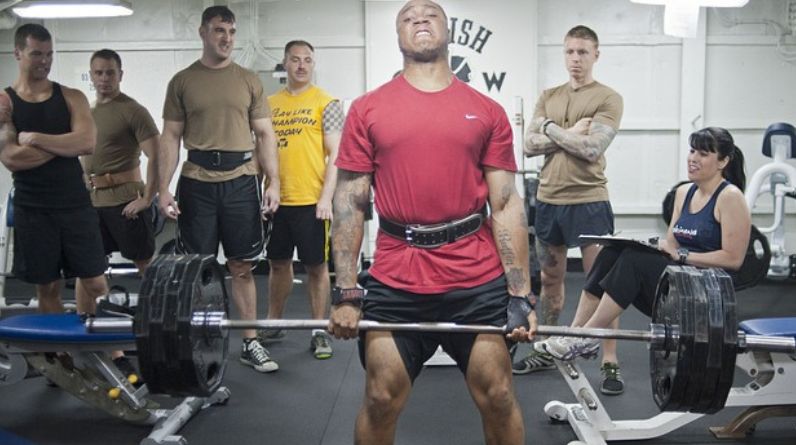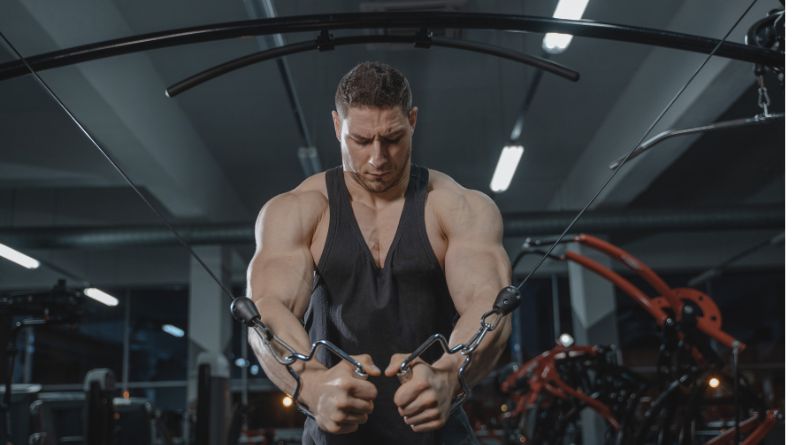
Introduction
Building muscle is a fundamental goal for many fitness enthusiasts, athletes, and bodybuilders. To achieve substantial muscle gains, a principle known as progressive overload plays a crucial role. Progressive overload is the process of gradually increasing the demand on the muscles during exercise, leading to continuous muscle growth and strength gains over time. In this article, we will delve into the concept of progressive overload, its significance in muscle development, and how to effectively apply it to your workout routine to achieve your muscle-building goals.
Understanding Progressive Overload
Progressive overload is a foundational principle in strength training and bodybuilding. It revolves around the idea of constantly challenging the muscles to adapt and grow stronger. When you engage in resistance training, such as weightlifting, your muscles experience stress and microtears. Through the recovery process, the muscles repair and grow, becoming better equipped to handle similar stresses in the future. However, if you continue to use the same weight or resistance level without increasing the demands on your muscles, they will eventually adapt and stop growing.
The Significance of Progressive Overload
Continuous muscle growth is dependent on the concept of progressive overload for several reasons:
1. Stimulating Muscle Growth:
Progressive overload is the driving force behind stimulating muscle growth, scientifically known as muscle hypertrophy. When you engage in resistance training or strength exercises, you subject your muscles to stress and tension. This stress leads to microscopic tears in the muscle fibers. During the recovery phase, the body repairs these microtears, making the muscle fibers thicker and stronger. Over time, this process of muscle fiber repair and growth results in greater muscle hypertrophy.
With progressive overload, you continually challenge your muscles by increasing the resistance, which leads to the recruitment of more muscle fibers during each workout. As the resistance becomes more challenging, your muscles need to adapt to the increasing demands, leading to more significant muscle growth. This process of muscle fiber recruitment and adaptation ensures that your muscles are continually stimulated for growth and development.
2. Strength Development:
Progressive overload plays a pivotal role in enhancing muscle strength. As you progressively increase the resistance or weight lifted during exercises, your muscles are forced to adapt and become stronger to handle the increased load. With consistent and gradual increases in resistance, you can lift heavier weights over time, which translates to improved strength levels.
Strength development is not solely about the size of the muscles but also involves neural adaptations. As you continually challenge your muscles with progressive overload, the nervous system becomes more efficient in activating the muscle fibers. This improvement in neuromuscular coordination allows you to generate more force and lift heavier weights, leading to enhanced strength gains.
3. Preventing Plateaus:
Plateaus are common in resistance training when the body becomes accustomed to a specific exercise routine, and progress stalls. The principle of progressive overload helps break through these plateaus by introducing new challenges to the muscles. By progressively increasing the resistance, changing exercise variations, or manipulating other training variables, you can disrupt the body’s adaptation process and reignite muscle growth.
Changing exercises or introducing variations can target the muscles from different angles and stimulate them in unique ways, preventing the muscles from becoming too efficient at a particular movement. The introduction of new challenges helps to keep the muscles engaged and responsive to training stimuli, thus avoiding stagnation in progress.
4. Injury Prevention:
Your training intensity needs to be gradually increased to avoid injuries. When implementing progressive overload, it’s crucial to allow your muscles, joints, and connective tissues enough time to adapt to the increased stress. This adaptation period helps reduce the risk of overuse injuries and strains that can result from sudden and excessive changes in training intensity.
Injury prevention is especially crucial as we age since tendons, ligaments, and joints may become less resilient to sudden changes in load. By incorporating progressive overload and giving your body time to adapt, you can minimize the risk of injuries and maintain a consistent workout routine.
5. Optimizing Performance:
Progressive overload not only contributes to muscle growth and strength but also plays a key role in optimizing overall athletic performance and functional strength. By continuously challenging your muscles, you enhance their ability to generate force and power, leading to improved athletic performance.
Functional strength, which relates to the ability to perform daily activities and sports-specific movements efficiently, benefits from progressive overload. As you progressively increase the resistance and challenge your muscles in various ways, you improve your ability to perform functional movements with greater ease and proficiency.
Applying Progressive Overload
To effectively apply progressive overload, you can manipulate various training variables in your workout routine. The following are some methods to use progressive overload:
1. Increase Weight:
Gradually increasing the weight lifted during resistance exercises is a fundamental way to implement progressive overload. As your muscles become stronger, they require more resistance to continue growing. The increase in weight can be as small as 2.5 to 5 pounds (1-2.5 kg), as even these minor increments create the necessary stimulus for muscle growth. This approach ensures that your muscles are continually challenged, leading to greater muscle hypertrophy over time.
2. Increase Repetitions:
Increasing the number of repetitions you perform in a set is another effective method of progressive overload. As your strength improves, you can perform more repetitions with the same weight. This higher volume of repetitions challenges your muscles to work with greater endurance levels, which is essential for overall muscle development and muscular endurance.
3. Increase Sets:
Adding more sets to your exercises can significantly increase the overall volume of your workout. By performing additional sets, you subject your muscles to more time under tension and a higher workload. This increased volume contributes to greater muscle growth and strength gains.
4. Adjust Rest Periods:
The length of rest periods between sets can influence the intensity of your workout. Shortening the rest periods can intensify the training session and increase the metabolic stress on your muscles. This metabolic stress triggers various physiological responses that promote muscle growth and adaptation.
5. Vary Exercise Selection:
Incorporating different exercises that target the same muscle groups is essential for effective progressive overload. Varying exercise selection provides fresh stimuli to the muscles, preventing them from becoming too efficient at a specific movement. This variation also ensures balanced muscle development and reduces the risk of overuse injuries.
6. Use Resistance Bands:
Resistance bands can be valuable tools for progressive overload, especially for bodyweight exercises. By incorporating resistance bands, you can add external resistance and create muscle tension at various points in the exercise, increasing the challenge for your muscles.
7. Change Tempo:
Altering the tempo of your repetitions can be an effective way to implement progressive overload. By using slower or faster movements during specific phases of an exercise, you can increase the time under tension for your muscles. This extended time under tension leads to increased muscle fiber recruitment and promotes greater muscle growth.
8. Implement Drop Sets:
Drop sets are an advanced technique used to intensify the workout and push the muscles further. To perform drop sets, complete a set of an exercise to failure, then immediately reduce the weight and continue for additional repetitions. This technique subjects the muscles to a high level of fatigue, promoting muscle growth and endurance.
9. Periodize Your Training:
Periodization involves dividing your training program into distinct phases, each with a specific training focus and intensity level. This approach optimizes muscle growth and recovery by strategically varying training volume and intensity over time. Periodization helps prevent training plateaus and allows for proper rest and recovery periods.
10. Track Progress:
Keeping a workout journal to record your lifts, repetitions, and other relevant data is essential for applying progressive overload effectively. Tracking your progress allows you to see your improvements over time and helps ensure that you are consistently challenging your muscles and making progress toward your fitness goals. It also provides valuable insights into what works best for your body and allows you to make informed adjustments to your training program.
Conclusion
Progressive overload is the backbone of continuous muscle growth and strength development. By consistently challenging your muscles and progressively increasing the demands on them, you can achieve significant gains in muscle size and strength. Whether you are a seasoned athlete or a beginner, incorporating progressive overload into your workout routine is essential for reaching your muscle-building goals. Remember to apply progressive overload safely and gradually to maximize your results and prevent injuries. With dedication and patience, you can embark on a journey of consistent muscle growth and overall fitness improvement.
Frequently Asked Questions
1. What is progressive overload, and why is it important for muscle growth?
Progressive overload is the gradual increase in the demands placed on muscles during exercise. It involves consistently challenging the muscles to adapt and grow stronger over time. By progressively increasing resistance, repetitions, or sets, progressive overload stimulates muscle adaptation and hypertrophy. This process is essential for muscle growth as it creates micro-tears in the muscle fibers, which the body repairs and strengthens during rest and recovery periods. Over time, this cycle of damage and repair leads to muscle growth and increased strength.
2. How often should I increase the weight or intensity in my workouts?
The frequency of increasing the weight or intensity depends on individual factors, such as training experience, fitness level, and recovery capacity. As a general guideline, aim to progress every 2-4 weeks. This allows your muscles enough time to adapt and recover from the increased demands. However, the key is to listen to your body and avoid progressing too quickly, as it may lead to overtraining or injuries.
3. Can I apply progressive overload with bodyweight exercises?
Yes, you can apply progressive overload to bodyweight exercises effectively. To do so, you can increase the difficulty of the exercises by performing more challenging variations or adding resistance through tools like weighted vests, resistance bands, or ankle weights. For example, you can progress from standard push-ups to decline push-ups or from bodyweight squats to pistol squats to increase the challenge.
4. Can I still use progressive overload if I’m unable to lift heavier weights due to injury or limitations?
Absolutely. Progressive overload is not limited to lifting heavier weights. If you have certain limitations or injuries, you can still apply progressive overload by adjusting other variables such as increasing repetitions, sets, or adjusting the tempo of your exercises. The goal is to continually challenge your muscles and push them beyond their current limits, regardless of the specific exercise or load.
5. Is it essential to reach muscle failure in every set to apply progressive overload?
No, reaching muscle failure in every set is not necessary for applying progressive overload. While training to failure can be beneficial for some individuals and certain phases of training, it’s not a requirement. The key to progressive overload is to focus on gradually increasing the challenge for your muscles over time. You should aim to complete each set with proper form, and as you progress, you’ll notice improvements in strength and performance.
6. How long does it take to see noticeable muscle gains with progressive overload?
The rate of muscle gain varies between individuals and depends on several factors, including genetics, training consistency, nutrition, and recovery. With consistent training and proper nutrition, some individuals may notice noticeable muscle gains within a few months, while others may take longer. Patience and dedication are essential when it comes to building muscle through progressive overload.
7. Can I apply progressive overload to cardiovascular exercises like running or cycling?
Progressive overload is primarily used in resistance training to stimulate muscle growth. However, you can apply similar principles to cardiovascular exercises like running or cycling. For example, you can progressively increase the distance, intensity, or duration of your cardio workouts to challenge your cardiovascular system and improve endurance.
8. What role does nutrition play in supporting muscle growth with progressive overload?
Nutrition plays a crucial role in supporting muscle growth when applying progressive overload. Consuming enough protein is crucial because it supplies the amino acids needed for muscle growth and repair. Additionally, overall caloric intake is important to provide the energy needed for intense workouts and the recovery process. Proper hydration and consuming nutrient-dense foods that support overall health also contribute to muscle growth and recovery.
9. Can I apply progressive overload in bodybuilding and powerlifting training equally?
Yes, progressive overload is a fundamental principle in both bodybuilding and powerlifting. However, the specific strategies may differ based on individual goals and training styles. Bodybuilders typically focus on higher repetition ranges to induce muscle hypertrophy, while powerlifters focus on lower repetition ranges to increase strength in specific lifts. Nevertheless, both disciplines rely on progressive overload to drive improvements in muscle size and strength.
10. Is there an upper limit to how much weight I should lift for progressive overload?
The weight you lift for progressive overload should be challenging yet manageable with proper form. While there is no specific upper limit, the goal is to continue making progress safely. Gradually increase the weight as you become stronger, but always prioritize maintaining proper technique to prevent injuries.






1 Comment
Comments are closed.